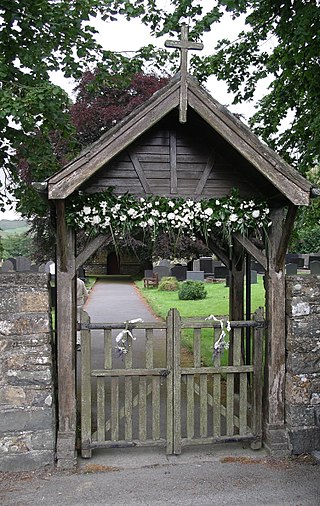
A lychgate, also spelled lichgate, lycugate, lyke-gate or as two separate words lych gate,, also wych gate, is a gateway covered with a roof found at the entrance to a traditional English or English-style churchyard. The name resurrection gate is also used. Examples exist also outside the British Isles in places such as Newfoundland, the Upland South and Texas in the United States, Australia, New Zealand, South Africa, Norway, and Sweden.
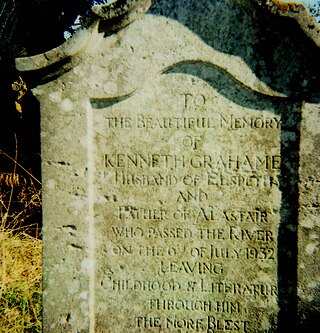
Holywell Cemetery is next to St Cross Church in Oxford, England. The cemetery is behind the church in St Cross Road, south of Holywell Manor on Manor Road and north of Longwall Street, in the parish of Holywell.

Wolvercote Cemetery is a cemetery in the parish of Wolvercote and district of Cutteslowe in Oxford, England. Its main entrance is on Banbury Road and it has a side entrance in Five Mile Drive. It has a funeral chapel, public toilets and a small amount of car parking. It was awarded plaques as a category winner of 'Cemetery of the Year' in 1999 and 2001.

St Martin's Church in Bladon near Woodstock, Oxfordshire, England, is the Church of England parish church of Bladon-with-Woodstock. It is also the mother church of St Mary Magdalene at Woodstock, which was originally a chapel of ease. It is best known for the graves of the Spencer-Churchill family, including Sir Winston Churchill, in its churchyard.

St Peter's Church, Leckhampton is the Church of England parish church in Leckhampton, Cheltenham, Gloucestershire, England. The church belongs to the Diocese of Gloucester, and is a member of the developing group of South Cheltenham Churches along with St Philip and St James Church, Leckhampton, St Christopher, Warden Hill, and St Stephen's and Emmanuel.
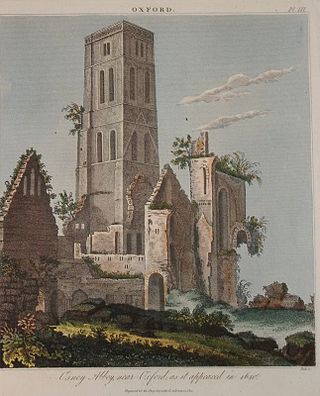
Osney Abbey or Oseney Abbey, later Osney Cathedral, was a house of Augustinian canons at Osney in Oxfordshire. The site is south of the modern Botley Road, down Mill Street by Osney Cemetery, next to the railway line just south of Oxford station. It was founded as a priory in 1129, becoming an abbey around 1154. It was dissolved in 1539 but was created a cathedral, the last abbot Robert King becoming the first Bishop of Oxford. The see was transferred to the new foundation of Christ Church in 1545 and the building fell into ruin. It was one of the four renowned monastic houses of medieval Oxford, along with St Frideswide's Priory, Rewley and Godstow.

St Sepulchre's Cemetery is a former cemetery located on Walton Street, Jericho, central Oxford, England.

Heanton Punchardon ( ) is a village, civil parish and former manor, anciently part of Braunton Hundred. It is situated directly east-southeast of the village of Braunton, in North Devon. The parish lies on the north bank of the estuary of the River Taw and it is surrounded, clockwise from the north, by the parishes of Braunton, Marwood, Ashford and across the estuary, Fremington. The population was 418 in 1801 and 404 in 1901. Its largest localities are Wrafton and Chivenor. The surrounding area is also an electoral ward with a total population at the 2011 census of 2,673.

St Thomas the Martyr Church is a Church of England parish church of the Anglo-Catholic tradition, in Oxford, England, near Oxford railway station in Osney. It is located between Becket Street to the west and Hollybush Row to the east, with St Thomas Street opposite.

St Helen's Church is in the village of Tarporley, Cheshire, England. It is an active Anglican parish church in the diocese of Chester, the archdeaconry of Chester and the deanery of Malpas. Its benefice is united with those of St John and Holy Cross, Cotebrook, St Thomas, Eaton, and St Paul, Utkinton. The church is recorded in the National Heritage List for England as a designated Grade II* listed building.
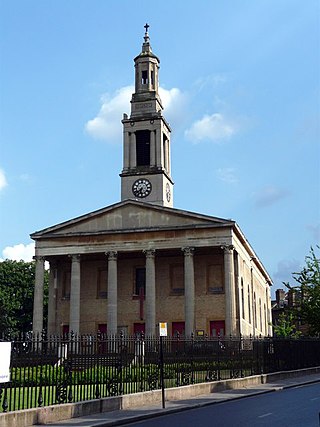
St Luke's Church in West Norwood is an Anglican church that worships in a Grade II* listed building. It stands on a prominent triangular site at the south end of Norwood Road, where the highway forks to become Knights Hill and Norwood High Street.

St Martin's Church is in Church Lane, Ashton upon Mersey, a district of Sale, Greater Manchester, England. It is recorded in the National Heritage List for England as a designated Grade II* listed building. It is an active Anglican parish church in the diocese of Chester, the archdeaconry of Macclesfield and the deanery of Bowdon.

St Michael and All Angels Church stands to the west of the village of Great Altcar, West Lancashire, England. The church is timber-framed and is recorded in the National Heritage List for England as a designated Grade II* listed building. It is an active Anglican parish church in the diocese of Liverpool, the archdeaconry of Liverpool and the deanery of Sefton. Its benefice is combined with that of Holy Trinity, Formby. In the Buildings of England series it is described as "an utterly charming church".

Queen's Road Cemetery is a cemetery in Croydon, England. It opened in 1861, and was followed in 1897 by the larger Croydon Cemetery in Mitcham Road. Both cemeteries are now managed by the London Borough of Croydon.
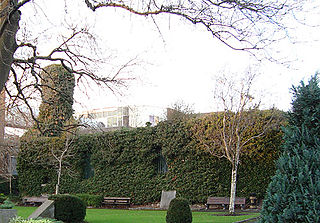
There was a St. Kevin's Church in what is now St. Kevin's Park, Camden Row, Dublin, Ireland at least as far as the 13th century. After the Reformation, it became an Anglican church. The original church was replaced around 1750 by a new one, closed in 1912 and now in ruins. Both churches were dedicated to Kevin of Glendalough. There is also a Catholic St. Kevin's Church a short distance away on Harrington Street.

The City of London Cemetery and Crematorium is a cemetery and crematorium in the east of London. It is owned and operated by the City of London Corporation. It is designated Grade I on the Historic England National Register of Historic Parks and Gardens.

The Church of St Peter-le-Bailey is a church on New Inn Hall Street in central Oxford, England. It was formerly next to Bonn Square, which was originally the churchyard. Now it is located halfway up New Inn Hall Street to the north. Several churches have existed on or close to the site. The current church is now the chapel of St Peter's College, Oxford.

The English coastal city of Brighton and Hove, made up of the formerly separate Boroughs of Brighton and Hove in East Sussex, has a wide range of cemeteries throughout its urban area. Many were established in the mid-19th century, a time in which the Victorian "cult of death" encouraged extravagant, expensive memorials set in carefully cultivated landscapes which were even recommended as tourist attractions. Some of the largest, such as the Extra Mural Cemetery and the Brighton and Preston Cemetery, were set in particularly impressive natural landscapes. Brighton and Hove City Council, the local authority responsible for public services in the city, manages seven cemeteries, one of which also has the city's main crematorium. An eighth cemetery and a second crematorium are owned by a private company. Many cemeteries are full and no longer accept new burials. The council maintains administrative offices and a mortuary at the Woodvale Cemetery, and employs a coroner and support staff.

St Thomas' Church is in Church Lane in the village of Henbury, Cheshire, England. It is an active Anglican parish church in the deanery of Macclesfield, the archdeaconry of Macclesfield, and the diocese of Chester. The church is recorded in the National Heritage List for England as a designated Grade II listed building.

St Mary Magdalen Roman Catholic Church, Mortlake, is a Roman Catholic church in North Worple Way, Mortlake, in the London Borough of Richmond upon Thames. The church is dedicated to Jesus' companion Mary Magdalene. It is located just south of Mortlake High Street and the Anglican St Mary the Virgin Church. St Mary Magdalen's Catholic Primary School is just north of the churchyard.






















